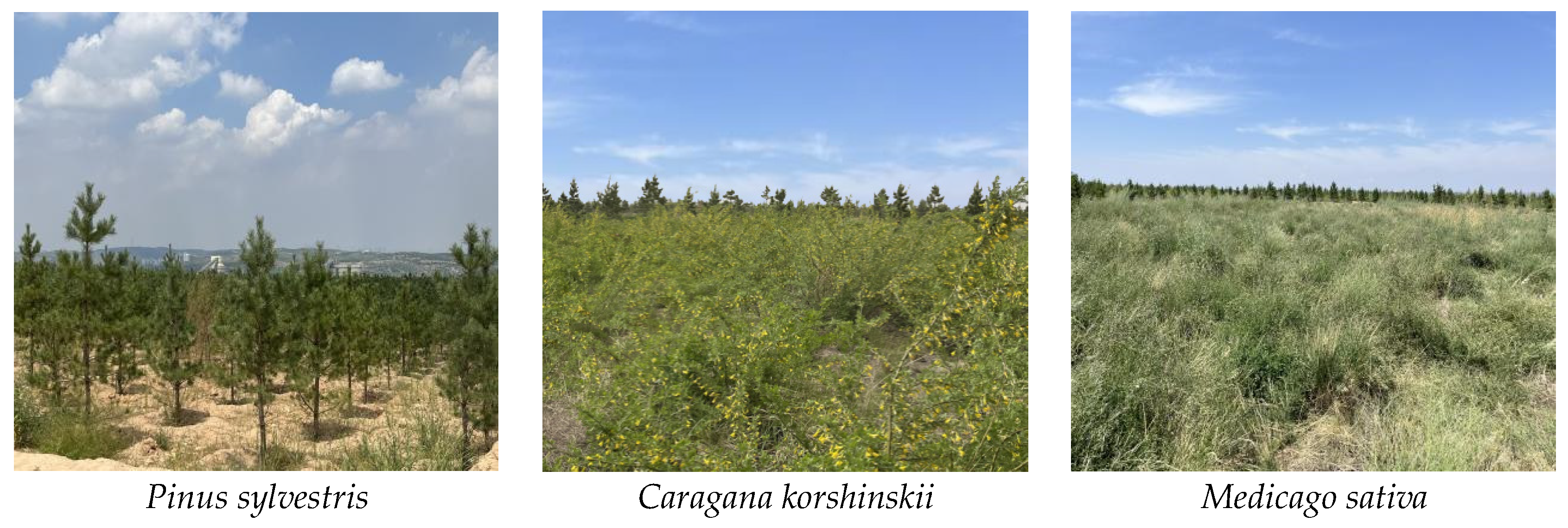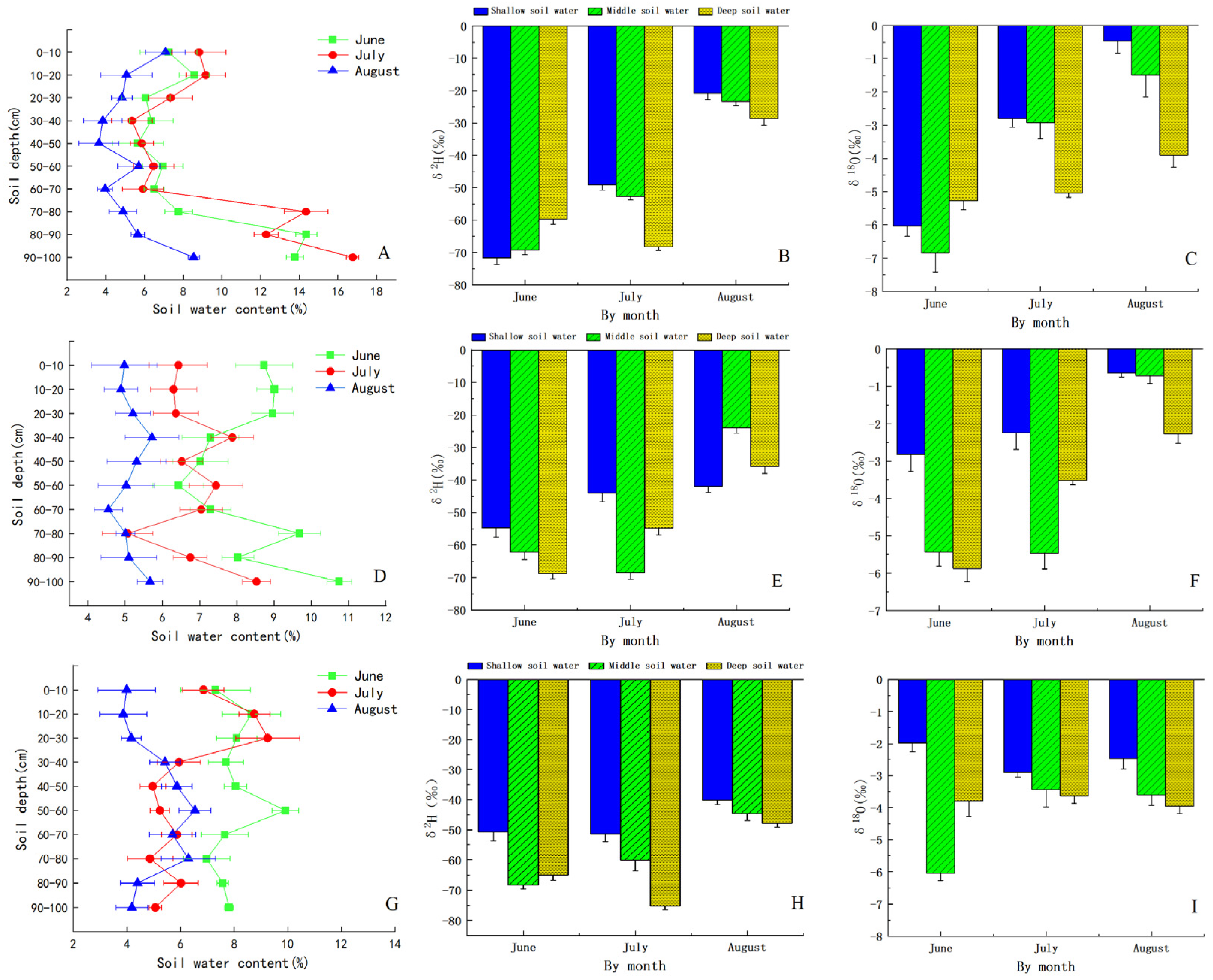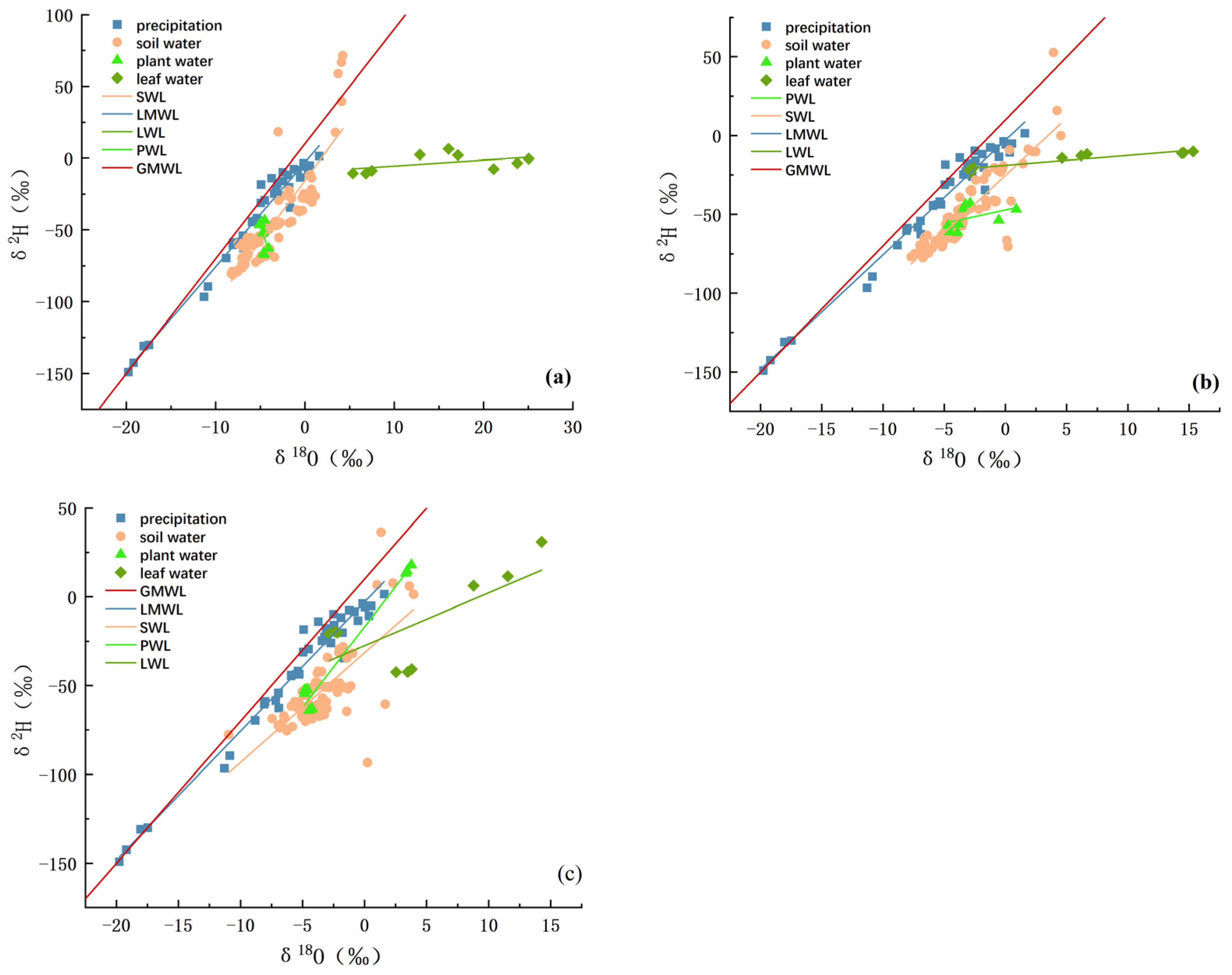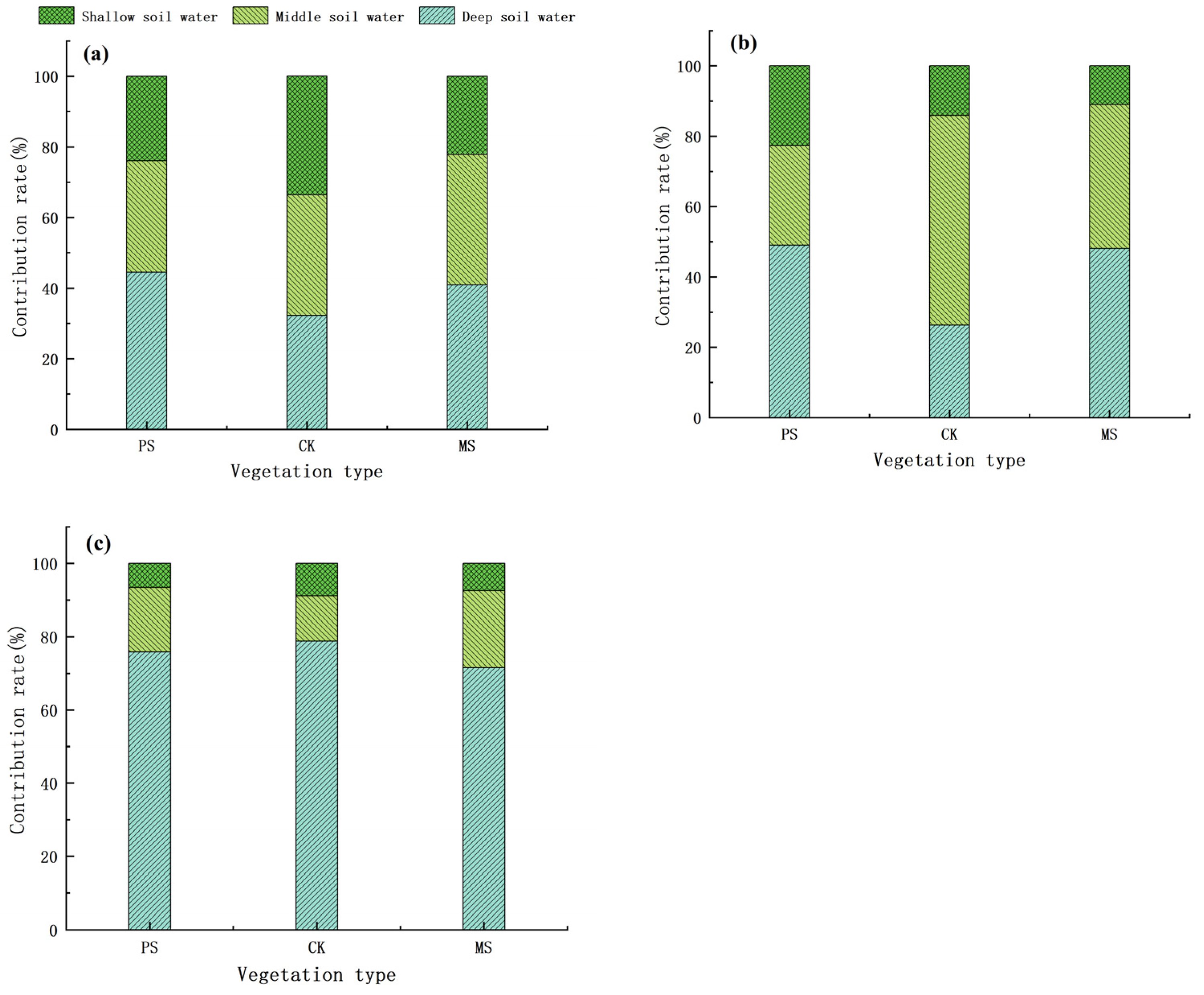Restoration Strategies in the Heidaigou Open-Pit Mine Dump Based on Water Sources and Plant Water Utilization
Abstract
:1. Introduction
2. Materials and Methods
2.1. Overview of the Study Area
2.2. Experimental Design and Sample Selection
2.3. Sample Collection
2.3.1. Plant Samples
2.3.2. Soil Samples
2.3.3. Rainfall Samples
2.4. Determination of Stable Hydrogen and Oxygen Isotopes
2.4.1. Sample Analysis
2.4.2. Excessive Calculation of the Water Body
2.4.3. Proportion of Plant Water Use
2.5. Division of Soil Water Sources
2.6. Data Processing and Analysis
3. Results
3.1. Analysis of Rainfall Characteristics
3.2. Changes in Soil Water Content and Isotopic Composition Characteristics
3.3. Isotopic Characteristics of Precipitation, Soil Water, Stem Water and Leaf Water
3.4. Characteristics of Water Use and Its Ratio of Different Plants
4. Discussion
4.1. Distribution Characteristics of Soil Moisture and Stable Isotope
4.2. Characteristics of δ2H and δ18O Compositions in Precipitation, Soil Water, Stem Water, and Leaf Water
4.3. Different Restoration Plant Water Sources
5. Conclusions
Author Contributions
Funding
Data Availability Statement
Conflicts of Interest
References
- Ding, D.; Jia, W.; Ma, X.; Wang, J. Water sources of dominant plants in subalpine shrubland of Qilian Mountains. Ecology 2018, 38, 1348–1356. [Google Scholar]
- Hao, S.; Li, F. Study on water use sources of typical desert vegetation in Ebinur Lake Basin. Geogr. J. 2021, 76, 1649–1661. [Google Scholar]
- Wu, H.W.; Li, X.Y.; Jiang, Z.Y.; Chen, H.Y.; Zhang, C.C.; Xiao, X. Contrasting water use pattern of introduced and native plants in an alpine desert ecosystem, Northeast Qinghai-Tibet Plateau. China Sci. Total Environ. 2016, 542, 182–191. [Google Scholar] [CrossRef]
- Wang, J.; Fu, B.J.; Lu, N.; Zhang, L. Seasonal variation in water uptake patterns of three plant species based on stable isotopes in the semi-arid Loess Plateau. Sci. Total Environ. 2017, 609, 27–37. [Google Scholar] [CrossRef]
- Su, P.; Zhang, M.; Qu, D.; Wang, J.; Zhang, Y.U.; Yao, X.; Xiao, H. Contrasting Water Use Strategies of Tamarix ramosissima in Different Habitats in the Northwest of Loess Plateau, China. Water 2020, 12, 2791. [Google Scholar] [CrossRef]
- Tang, J. Soil Environmental Effects of Vegetation Restoration in Opencast Coal Mine Dump in Loess Area. Master’s Thesis, Graduate School of Chinese Academy of Sciences (Soil and Water Conservation and Ecological Environment Research Center of Ministry of Education), Beijing, China, 2015. [Google Scholar]
- Yang, G.; Wang, L. Water sources and utilization strategies of two typical plants in the dump of Heidaigou open-pit mine. J. Nat. Resour. 2016, 31, 477–487. [Google Scholar]
- Peng, L. Study on Water Sources of Typical Desert Plants Based on Oxygen Stable Isotopes. Master’s Thesis, Xinjiang University, Urumqi, China, 2019. [Google Scholar]
- Shao, T. Screening of Suitable Plant Species for Vegetation Restoration in Grassland Opencast Coal Mine Dump. Master’s Thesis, Inner Mongolia Agricultural University, Hohhot, China, 2021. [Google Scholar]
- Qi, X. Study on the Effect of Vegetation Reconstruction and Restoration in the Dump of Open-Pit Coal Mine in Xilin Gol League. Master’s Thesis, Inner Mongolia Agricultural University, Hohhot, China, 2017. [Google Scholar]
- Lü, G. Study on Soil Hydrological Effects of Vegetation Restoration in Open-Pit Coal Mine Dump. Ph.D. Thesis, Shenyang Agricultural University, Shenyang, China, 2017. [Google Scholar]
- Xue, J. Study on Physical Characteristics and Improvement of Soil Moisture in Dump of Mining Area. Master’s Thesis, Northwest University of Agriculture and Forestry, Xianyang, China, 2015. [Google Scholar]
- Pang, Z. Research on the Present Situation and Control Countermeasures of Soil Erosion Disaster in the Northern Dump of Jinduicheng. Master’s Thesis, Chang’an University, Xi’an, China, 2014. [Google Scholar]
- Feng, Y. Effects of Mechanical Compaction on Soil Macropore Structure and Hydraulic Characteristics of Dump in Large Open-Pit Coal Mining Area. Ph.D. Thesis, China University of Geosciences (Beijing), Beijing, China, 2019. [Google Scholar]
- Gu, Y. Study on Water and Fertilizer Response and Spatial Variation of Vegetation Restoration in Opencast Coal Mine Dump in Loess Area. Master’s Thesis, China University of Geosciences (Beijing), Beijing, China, 2017. [Google Scholar]
- Xu, H.; Li, Y. Water-use strategy of three central Asian desert shrubs and their responses to rain pulse events. Plant Soil 2006, 285, 5–17. [Google Scholar] [CrossRef]
- Delzon, S.; Loustau, D. Age-related decline in stand water use: Sap flow and transpiration in a pine forest chronosequence. Agric. For. Meteorol. 2005, 129, 105–119. [Google Scholar] [CrossRef]
- Nie, Y.; Chen, H.; Wang, K. Study method of plant water source in shallow soil layer. Appl. Ecol. 2010, 21, 2427–2433. [Google Scholar]
- Hardanto, A.; Röll, A.; Hölscher, D. Tree soil water uptake and transpiration in mono-cultural and jungle rubber stands of Sumatra. For. Ecol. Manag. 2017, 397, 67–77. [Google Scholar] [CrossRef]
- Zhang, B.J.; Li, Z.X.; Wang, Y.; Li, Y.G.; Lü, Y.M.; Yuan, R.F.; Gui, J. Characteristics of stable isotopes and analysis of water vapor sources of precipitation at the northern slope of the Qilian mountains. Environ. Sci. 2019, 40, 5272–5285. [Google Scholar]
- Dawson, T.E.; Ehleringer, J.R. Streamside trees that do not use stream water. Nature 1991, 350, 335–337. [Google Scholar] [CrossRef]
- Yang, A.; Fu, Z.; Wang, L.; Xiao, F.; Wang, L.; Fan, P.; Zhang, J. Water use strategy of poplar in Horqin sandy land. J. Beijing For. Univ. 2018, 40, 63–72. [Google Scholar]
- Sprenger, M.; Leistert, H.; Gimbel, K.; Weiler, M. Illuminating hydrological processes at the soil-vegetation-atmosphere interface with water stable isotopes. Rev. Geophys. 2016, 54, 674–704. [Google Scholar] [CrossRef]
- McCole, A.A.; Stern, L.A. Seasonal water use patterns of Juniperus ashei on the Edwards Plateau, Texas, based on stable isotopes in water. J. Hydrol. 2007, 342, 238–248. [Google Scholar] [CrossRef]
- Pei, Y.; Huang, L.; Li, R.; Shao, M.; Zhang, Y. Sources and influencing factors of root water absorption of Pinus sylvestris var. mongolica plantation in southeastern margin of Mu Us Sandy Land. Soil Sci. J. 2022, 59, 1336–1348. [Google Scholar]
- Williams, D.G.; Ehleringer, J.R. Intra- and Interspecific Variation for Summer Precipitation Use In Pinyon-Juniper Woodlands. Ecol. Monogr. 2000, 70, 517–537. [Google Scholar]
- Martín-Gómez, P.; Barbeta, A.; Voltas, J.; Peñuelas, J.; Dennis, K.; Palacio, S.; Dawson, T.E.; Ferrio, J.P. Isotope-Ratio Infrared Spectroscopy a reliable tool for the investigation of plant-water sources? New Phytol. 2015, 207, 914–927. [Google Scholar] [CrossRef] [PubMed]
- Pu, H.; Song, W.; Wu, J. Using Soil Water Stable Isotopes to Investigate Soil Water Movement in a Water Conservation Forest in Hani Terrace. Water 2020, 12, 3520. [Google Scholar] [CrossRef]
- Dai, J.; Zhang, X.; Luo, Z.; Wang, R.; Liu, F.; He, X. Stable isotope characteristics of soil water in camphor forest in Changsha and its indication for soil water movement. Environ. Sci. Res. 2019, 32, 974–983. [Google Scholar]
- Ding, F.; Yuan, C.; Zhou, T.; Cheng, J.; Wu, P.; Ye, Y. Water-Use Strategies and Habitat Adaptation of Four Tree Species in Karstic Climax Forest in Maolan. Water 2023, 15, 203. [Google Scholar] [CrossRef]
- Landwehr, J.; Coplen, T.B. Line-conditioned excess: A new method for characterizing stable hydrogen and oxygen isotope ratios in hydrologic systems. Int. Conf. Isot. Environ. Stud. 2006, 118, 132–135. [Google Scholar]
- Sprenger, M.; Tetzlaff, D.; Soulsby, C. Soil water stable isotopes reveal evaporation dynamics at the soil–plant–atmosphere interface of the critical zone. Hydrol. Earth Syst. Sci. 2017, 21, 3839–3858. [Google Scholar] [CrossRef]
- Landwehr, J.M.; Coplen, T.B.; Stewart, D.W. Spatial, seasonal, and source variability in the stable oxygen and hydrogen isotopic composition of tap waters throughout the USA. Hydrol. Process. 2014, 28, 5382–5422. [Google Scholar] [CrossRef]
- Phillips, D.L.; Newsome, S.D.; Gregg, J.W. Combining sources in stable isotope mixing models: Alternative methods. Oecologia 2005, 144, 520–527. [Google Scholar] [CrossRef]
- Xu, X.; Li, Y.; Tan, Z.; Guo, Q. Isotope tracing of water use sources of typical mesophytes in Poyang Lake wetland. Lake Sci. 2020, 32, 1749–1760. [Google Scholar]
- Su, W.; Jia, D.; Gao, R.; Lu, J.; Lu, F.; Zhao, F.; Wang, F. Water use characteristics of artificial sand-fixing vegetation in the southern margin of Hunshandake Sandy Land. Appl. Ecol. 2021, 32, 1980–1988. [Google Scholar]
- Luo, L.; Gao, X.; Zhao, L.; An, Q.; Ma, N.; Zhao, X. Response of water use strategy of vegetation community to drought stress in loess hilly region. J. Soil Water Conserv. 2023, 37, 280–288. [Google Scholar]
- Liu, Z.; Yu, X.; Jia, G.; Jia, J.; Lou, Y.; Lu, W. Contrasting water sources of evergreen and deciduous tree species in rocky mountain area of Beijing, China. Catena 2017, 150, 108–115. [Google Scholar] [CrossRef]
- Archer, N.A.; Otten, W.; Schmidt, S.; Bengough, A.G.; Shah, N.; Bonell, M. Rainfall infiltration and soil hydrological characteristics below ancient forest, planted forest and grassland in a temperate northern climate. Ecohydrology 2016, 9, 585–600. [Google Scholar] [CrossRef]
- Piles, M.; Entekhabi, D.; Konings, A.G.; McColl, K.A.; Das, N.N.; Jagdhuber, T. Multi-temporal microwave retrievals of Soil Moisture and vegetation parameters from SMAP. In Proceedings of the 2016 IEEE International Geoscience and Remote Sensing Symposium (IGARSS), Beijing, China, 10–15 July 2016. [Google Scholar] [CrossRef]
- Liu, X.; Li, Z.; Liu, M.; Xu, B.; Gui, J.; Cui, Q.; Xue, J.; Duan, R. Quantitative analysis of plant water sources in the source region of the Yangtze River. China Desert 2024, 44, 102–110. [Google Scholar]
- Pei, Y.; Huang, L.; Shao, M.; Li, R. Characteristics and influencing factors of soil water recharge under different groundwater depths in Zhang Yinglong and Maowusu sandy land. Acta Agric. Eng. Sci. 2021, 37, 108–116. [Google Scholar]
- Brinkmann, N.; Seeger, S.; Weiler, M.; Buchmann, N.; Eugster, W.; Kahmen, A. Employing stable isotopes to determine the residence times of soil water and the temporal origin of water taken up by Fagus sylvatica and Picea abies in a temperate forest. New Phytol. 2018, 219, 1300–1313. [Google Scholar] [CrossRef] [PubMed]
- He, C.; Liu, T.; Duan, L.; Wang, G.; Hao, L. Water use characteristics of Artemisia halodendron in the Horqin Sandy Land. Deserts China 2022, 42, 190–198. [Google Scholar]
- Li, J.; Wu, H.; Zhao, B.; Chen, J.; Song, G. Root architecture characteristics of common slope protection plants at seedling stage under simulated slope conditions. Ecology 2023, 43, 10131–10141. [Google Scholar]
- Xu, S.; Zhu, Y.; Wu, C.; Li, Y. Water use strategies of three soil and water conservation tree species in Ordos Plateau. Appl. Ecol. 2020, 31, 2885–2892. [Google Scholar]
- Ehleringer, J.R. Water uptake by plants: Perspectives from stable isotope composition. Plant Cell Environ. 1992, 15, 1073–1082. [Google Scholar] [CrossRef]
- Liu, Z.Q.; Yu, X.X.; Jia, G.D.; Jia, J.B.; Lou, Y.H.; Zhang, K. Water use characteristics of Platycladus orientalis and Quercus variabilis in Beijing mountainous area. For. Sci. 2016, 52, 22–30. [Google Scholar]
- Kan, J.; Jia, D.; Guo, S.; Qian, L. Isotopic tracing of water source of Salix gordejevii growing season in Hunshandake Sandy Land in 2014. Arid Area Study 2017, 34, 350–355. [Google Scholar]
- Deng, W.; Yu, X.; Jia, G.; Li, Y.; Liu, Y. Water sources of three typical plants in Beijing mountainous area during rainy season. Study Arid Area 2014, 31, 649–657. [Google Scholar]
- Xu, Y.; Guan, J.; Deng, L. Characteristics and influencing factors of vegetation and soil moisture change in sandy land in alpine and semi-arid region. Acta Ecol. Sin. 2024, 13, 1–13. [Google Scholar] [CrossRef]
- Wu, G.; Zhang, D.; Zhang, Z.; Dan, L. Spatial structure characteristics of sand-fixing shrubs on semi-fixed dunes in Gurbantunggut Desert. J. Grassl. 2024, 1–21. Available online: http://kns.cnki.net/kcms/detail/11.3362.S.20240417.1338.014.html (accessed on 20 May 2024).








| Plot Type | New Structure Covering Soil | Reclamation Years/a | Elevation above Sea Level/m | Soil Composition/% | Bulk Density/(g/cm3) | Total Nitrogen/(g/kg) | Total Phosphorus/(g/kg) | Total Potassium/(g/kg) | ||
|---|---|---|---|---|---|---|---|---|---|---|
| Clay | Silt | Sand | ||||||||
| Pinus sylvestris | yellow loamy soil | 2014 | 1218 | 8.73 | 51.66 | 39.61 | 1.58 | 0.15 | 0.37 | 15.71 |
| Caragana korshinskii | yellow loamy soil | 2014 | 1224 | 8.29 | 64.21 | 27.5 | 1.57 | 0.18 | 0.43 | 14.29 |
| Medicago sativa | yellow loamy soil | 2014 | 1206 | 7.93 | 65.5 | 26.57 | 1.48 | 0.17 | 0.40 | 15.35 |
| Plant Form | Position (° ′ ″) | Orientation | Elevation/m | Plant Height/m | Crown/m | Plant Spacing/m | Life Form |
|---|---|---|---|---|---|---|---|
| Pinus sylvestris | 39°79′17″ N 111°27′07″ E | Northwest | 1218 | 2.52 ± 0.3 | (2.53 ± 0.12) × (1.81 ± 0.05) | 2 × 2 | Evergreen trees |
| Caragana korshinskii | 39°78′51″ N 111°26′49″ E | South | 1224 | 1.55 ± 0.2 | (1.97 ± 0.1) × (1.74 ± 0.09) | 2 × 2 | Evergreen shrubs |
| Medicago sativa | 39°78′48″ N 111°26′51″ E | East | 1206 | 1.12 ± 0.15 | (1.76 ± 0.11) × (1.57 ± 0.07) | 2 × 2 | Perennial herbs |
| Water Body Type | Vegetation Type | δ2H | δ18O | Fitting Equation | R2 |
|---|---|---|---|---|---|
| Atmospheric precipitation | −149.1‰ to 1.44‰ | −19.77‰ to 0.53‰ | δ2H = 7.27δ18O − 2.95 | 0.97 | |
| Soil water | Pinus sylvestris | −81.37‰ to 71.36‰ | −8.25‰ to 4.25‰ | δ2H = 7.18δ18O − 15.59 | 0.77 |
| Caragana korshinskii | −77.51‰ to 52.73‰ | −7.71‰ to 4.52‰ | δ2H = 7.25δ18O − 25.28 | 0.77 | |
| Medicago sativa | −93.35‰ to 36.34‰ | −10.95‰ to 3.96‰ | δ2H = 6.17δ18O − 31.49 | 0.52 | |
| Xylem water | Pinus sylvestris | −67.06‰ to −43.32‰ | −5.1‰ to 0.07‰ | δ2H = −16.83δ18O − 132.52 | 0.19 |
| Caragana korshinskii | −61.55‰ to −42.93‰ | −4.69‰ to 0.88‰ | δ2H = 1.70δ18O − 47.21 | 0.07 | |
| Medicago sativa | −63.94‰ to −17.97‰ | −4.83‰ to 3.77‰ | δ2H = 9.07δ18O − 16.89 | 0.97 | |
| Leaf water | Pinus sylvestris | −10.69‰ to 6.47‰ | 5.36‰ to 25.05‰ | δ2H = 0.41δ18O − 9.63 | 0.12 |
| Caragana korshinskii | −23.06‰ to −10.05‰ | −2.97‰ to 15.33‰ | δ2H = 0.64δ18O − 18.90 | 0.85 | |
| Medicago sativa | −42.49‰ to 30.96‰ | −2.84‰ to 14.27‰ | δ2H = 2.98δ18O − 27.50 | 0.43 | |
Disclaimer/Publisher’s Note: The statements, opinions and data contained in all publications are solely those of the individual author(s) and contributor(s) and not of MDPI and/or the editor(s). MDPI and/or the editor(s) disclaim responsibility for any injury to people or property resulting from any ideas, methods, instructions or products referred to in the content. |
© 2024 by the authors. Licensee MDPI, Basel, Switzerland. This article is an open access article distributed under the terms and conditions of the Creative Commons Attribution (CC BY) license (https://creativecommons.org/licenses/by/4.0/).
Share and Cite
Wang, J.; Li, L.; Zhang, L.; Li, Q.; Liu, K. Restoration Strategies in the Heidaigou Open-Pit Mine Dump Based on Water Sources and Plant Water Utilization. Forests 2024, 15, 906. https://doi.org/10.3390/f15060906
Wang J, Li L, Zhang L, Li Q, Liu K. Restoration Strategies in the Heidaigou Open-Pit Mine Dump Based on Water Sources and Plant Water Utilization. Forests. 2024; 15(6):906. https://doi.org/10.3390/f15060906
Chicago/Turabian StyleWang, Jing, Long Li, Liang Zhang, Qiang Li, and Kun Liu. 2024. "Restoration Strategies in the Heidaigou Open-Pit Mine Dump Based on Water Sources and Plant Water Utilization" Forests 15, no. 6: 906. https://doi.org/10.3390/f15060906




